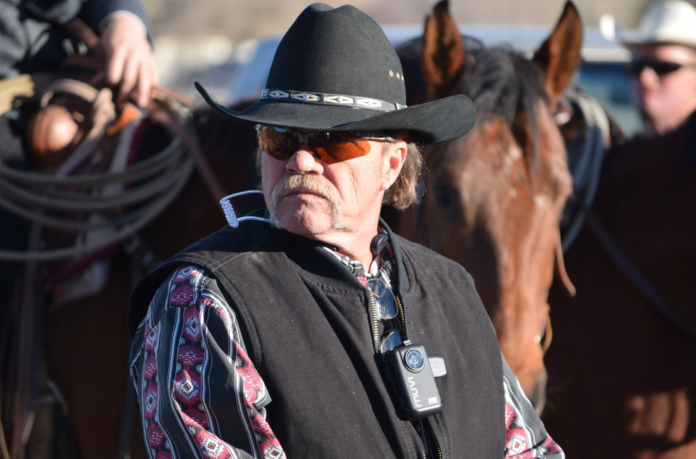
SALT LAKE CITY, Utah, July 9, 2018 (Gephardt Daily) — William Keebler, the Utah militia leader who pleaded guilty to the attempted bombing of a remote Bureau of Land Management facility in northern Arizona in 2016, has been released from federal custody.
Keebler, 59, a longtime resident of Stockton, Utah, spent 22 months behind bars before pleading guilty in April 2018 to one count of attempted destruction of federal property by use of an explosive. He spent another two months awaiting sentencing.
Under the terms of the April plea agreement, Keebler faced a potential sentence of 12 to 70 months in a federal lockup.
Instead, U.S. District Judge David Sam stunned the courtroom, sentencing the self-styled militia leader to time served. Sam said Keebler had been a model prisoner and shown genuine remorse for his actions. He also cited Keebler’s age and ongoing medical issues.
Keebler’s friends were overwhelmed by the court’s decision. They had been present at each of Keebler’s court appearances over the last two years, and visited him regularly at the Weber County Jail, where he’d been held since the summer of 2016.
While asking not to be named, Keebler’s supporters told Gephardt Daily they wanted to “express their gratitude to Judge Sam for releasing Bill with time-served. We are relieved and happy.”
Another supporter expressing gratitude for Keebler’s release was Carol Bundy, wife of controversial Nevada rancher Cliven Bundy.
Keebler first came under federal scrutiny in 2014 when he joined militia members from across the West in a 13-day standoff against heavily armed BLM agents outside Bundy’s Bunkerville, Nevada, ranch.
Federal officials were attempting to seize Bundy’s cattle in an effort to recoup millions of dollars in unpaid federal grazing fees — fees the Bundys say they don’t owe.
“It’s a happy day when men who have been indicted and held unjustly get to come home. America can celebrate,” Carol Bundy told reporter Bill Gephardt.
“We’re finding more and more injustice in the system,” she said. “I don’t know how we’re going to fix it, but we’re going to celebrate every time one comes home.”
It’s familiar territory for Bundy.
Five family members — husband Cliven and sons Ammon, Ryan, Mel and David — spent more than a year in federal detention while awaiting trial on federal conspiracy charges stemming from the Bunkerville standoff, and the armed takeover of the Malheur National Wildlife Refuge outside Burns, Oregon, in 2016.
In the end, nearly all of the defendants in both cases were freed — in Oregon, by way of jury’s verdict, and in Nevada by way of a judge’s dismissal after Judge Anna Navarro determined prosecutors bungled the case by withholding key evidence from the defense.
“You know my family sat in prison and they learned to love the men they were with,” Bundy said. “We’re finding more and more injustice in the system. I don’t know how we’re going to fix it, but we’re going to celebrate every time one comes home.”
One of those who didn’t come home was Robert “LaVoy” Finicum, the Arizona rancher who was a friend and follower of the Bundys, and spokesman for the occupiers of Malheur wildlife refuge. He was shot and killed during a confrontation with Oregon State Police and the FBI.
It was Keebler’s association with both the Bundys and Finicum that caught the FBI’s attention.
According to the original probable cause statement, Keebler was arrested just hours after he attempted to trigger what he thought was an explosive device placed at the door of a BLM cabin in Mount Trumbull, Arizona.
Charging documents reveal the bomb was a dummy, built and planted by undercover FBI agents who had infiltrated Keebler’s militia group.
Prosecutors said Keebler was the commander of the Patriots Defense Force (PDF) headquartered in Tooele County. They claimed he and members of his small militia group had been actively plotting to bomb BLM facilities, including an office at the Gateway Mall in downtown Salt Lake City.
Keebler was also alleged to have scouted a mosque in the Salt Lake City area and spoke of killing Muslims.
The original probable cause statement also claimed Finicum had joined Keebler on an October 2015 reconnaissance mission of the Mount Trumbull facility. The FBI amended that statement in a subsequent detention hearing, saying Finicum was attending a rodeo that day.
The probable cause statement paints a striking portrait of the FBI’s efforts to infiltrate militia groups involved in the 2014 Bunkerville standoff and the Oregon occupation.
“For several months, undercover employees (UCEs) of the FBI have been members of the PDF. The undercover employees had face-to-face interactions with Keebler, as well as cellular phone conversations and communications,” the probable cause statement said.
“The UCEs have participated in field training exercises (FTXes) organized by Keebler during which PDF members practice shooting at targets and receive instructions regarding firearms and military survival tactics.”
Federal prosecutors said those training exercises intensified in the months following the Bunkerville showdown, with Keebler telling militia members in May 2015 that he was putting a team together “to go on the offensive.”
On March 19, 2016, Keebler told militia members the government had been allowed to harass people, but “repercussions were going to start.”
Those repercussions, according to the FBI, included planned attacks on BLM facilities “in the middle of nowhere” with the goal of doing “severe damage of BLM vehicles or buildings.”
Keebler then allegedly tasked a PDF member to “build an explosive device that could disable a BLM vehicle or damage a building.” That PDF member, according to the charging documents, was an undercover FBI employee.
On April 8, 2016, the undercover employee demonstrated the power of two pipe bombs showing a video of office furniture being blown apart in southern Utah. Keebler was allegedly impressed by the display and asked the undercover agent to build two new explosive devices that would be twice as powerful as the first.
The first bomb, Keebler said, needed to be triggered via remote control signal from a walkie talkie, and would be used in blowing up a cabin at the BLM outpost in Trumbull, Arizona.
The second bomb was to have a time fuse and be used against law enforcement officers should PDF members be stopped heading into or out of the Mount Trumbull facility.
On Monday, June 20, Keebler and other militia members, including undercover FBI agents, left Stockton, Utah, and arrived in Arizona, where they once again surveilled the BLM property.
The following night, Keebler was handed a remote control detonator by one of the undercover agents and told it would set off an explosive device left at the door of one of the BLM cabins.
According to the charging documents, “Keebler then pushed the detonator button multiple times in order to remotely detonate the inert explosive. After the remote detonation, Keebler departed Mount Trumbull and returned to Utah.”
Keebler was taken into custody by the FBI the next morning at a Nephi gas station and booked into jail.
Terms of Keebler’s release remand him to 3 years of reporting probation, during which time he must undergo mental health evaluations, take mental health medications as required, not possess or consume alcohol, and surrender all of his firearms to authorities, including a .45 caliber handgun and the rifle he carried to Mount Trumbull.
Keebler returned Monday night to a home that he shares in Stockton, where he was greeted by a close circle of friends.






